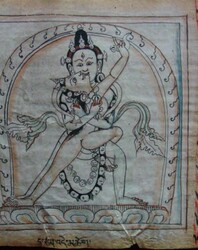
Buddhist Deity: Chakrasamvara, Heruka
Heruka Chakrasamvara Masterworks Subjects, Topics & Types:
- Description (below)
- Medium:
--- Painting & Textile
--- Sculpture
- Heruka Meaning & Forms
- Chakrasamvara Page
- Others...
Videos:
- Heruka (General)
- Heruka Chakrasamvara
Tibetan: Khor lo dem chog
Iconography:
- Solitary (Blue)
- Couple:
--- Consort, One Leg Up (Red, Blue)
--- Two Legs Up (Red)
--- Confusions: Heruka, Heruka Hevajra/Mahamaya/Buddhakapala, White Chakrasamvara
- Others...
Chakrasamvara Sahaja Heruka (Tibetan: khor lo dem chog, English: Wheel of Supreme Bliss): the foremost meditational deity of the Wisdom-mother classification of Anuttarayoga Tantra of Tantric Buddhism. Heruka Chakrasamvara is easily confused with Heruka Hevajra, Mahamaya and Buddhakapala. Sahaja Heruka (Tib. lhan cig skyes pa) generally refers to a deity with a consort and the sole term of Heruka can refer to a solitary male figure such as Hevajra, Chakrasamvara, Vajrabhairava and others. There is no confusion with the two, Guhyasmaja and Vajrabhairava, because Heruka Guhyasamaja is in a seated posture and Heruka Vajrabhairava has a buffalo head. There has not yet been a white 'Heruka' Chakrasamvara identified on the HAR website. White forms of Chakrasamvara are typically unique and fixed in their appearance and do not usually have a secondary or simple appearance other than the textual description.
"Chakrasamvara, blue in colour, the right foot is extended pressing on red Kalaratri and the left drawn in [pressing] on black Bhairava. With one face and two hands, three eyes, the right hand holds a vajra and the left a bell; embracing the consort, with a crown of five dry human heads as a crown, a necklace of fifty wet, and adorned with the six bone ornaments. [Chakrasamvara is] embraced by the consort Vajravarahi, red in colour, with one face and two hands. The right hand holds a curved knife pointed to the ten directions. The left holds a skullcup filled with the five nectars and embraces the Father. [She is] adorned with a crown of five dry human heads, a [necklace] of fifty dry [heads] and the five bone ornaments." (Jamyang Kyentse Wangpo, 1820-1892).
The meditational deity Chakrasamvara is common to all the New Schools of Himalayan and Tibetan Buddhism (Sarma: Sakya, Kagyu and Gelug). Within the Gelug School the deity is commonly referred to as Heruka. Among the many different forms and mandalas of practice, this form with one face and two hands entered Tibet with the great translator Rinchen Zangpo in the 11th century.
Database Search: All Images | Painting | Sculpture
Jeff Watt 9-2006 [updated 8-2017, 10-2023, 2-2025]











